Alia Sinha
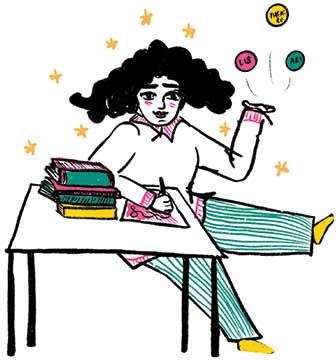
I’m an illustrator, theatre practitioner, and library worker. This illustrated essay is comprised of notes and reflections on my practice of facilitating physically embodied play and performativity in the context of the library – in the LEC (Library Educators’ Course) and other professional development workshops for Library education offered by Bookworm, Goa between the years 2017 and 2023.
I use methods informed by applied theatre (mostly absurd games and activities).This may involve running, chasing or following each other, hiding, walking strangely, counting together, pretending the floor is covered in ice or lava, becoming machines, mythical creatures or different characters, talking in made up languages or not talking at all, making still images, and adapting storybooks into full-fledged performances.
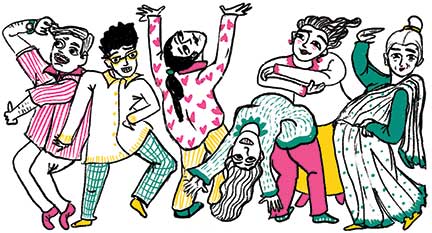
If you are confused right now, that’s probably a good thing. It’s often the first reaction of participants in these sessions.
Like them, I invite you to “go with it” for now.
Playing as an approach
At its core, this type of play centres the vulnerable, breathing natural bodies of the people inhabiting a space and recognizes the agency and presence of the body in the experience of learning.
Within a classroom, conference, or workshop, the physical orientation is most often a static arrangement where a group of ‘learners’ are required to sit still for hours, facing the presenter/educator and process complex ideas intellectually while possibly experiencing bodily discomfort or disconnection from the session.
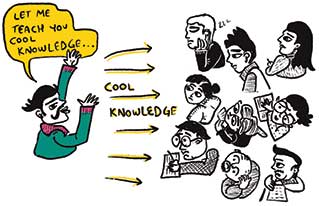
Typically, the imparter of knowledge is seen as separate from the group, in a hierarchical position of authority – as reflected by the design of the space. The flow of information and action is uni-directional going from them to the group, whose passive bodies are required to absorb this knowledge. Sessions on play shatter this structure.
The space in the centre is open – allowing for free movement and multiple configurations of bodies.
The group forms a circle, facing each other, and the facilitator is part of the circle, or weaving in and out of the space. Everyone is enmeshed in a web of feedback – responding, observing, and listening to each other. As the body moves, in harmony with the bodies of its peers – stretching, flowing, experiencing freedom – the learning space changes radically. What was up till that point a classroom/workshop/conference becomes suddenly unfamiliar, mysterious, filled with possibility.
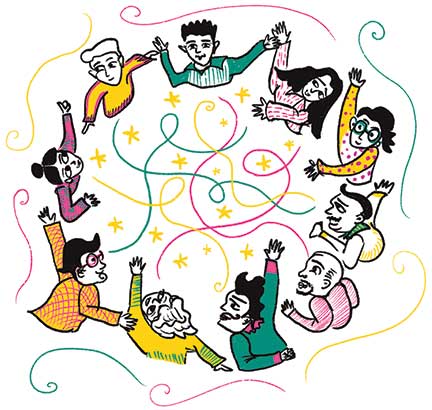
Physical embodiment
Each game or activity has different affective qualities. Some are just silly and funny. They make people laugh, loosen up and become softer and more open to the work. Some games work to bring the energy up, while others require vulnerability and sustained engagement with each other and a slower pace. Most strengthen the feeling of camaraderie, requiring people to cooperate and collaborate in order to “win”. Others allow people to go into a state of deep rest.
Some games are improvisational, allowing the participants to build and create their own stories, others let them experience different states of flow and movement.
The connections between these different types of activities determine the flow of the session.
There are games for the whole group – played in a large circle or spread through the space and interacting with each other, games played in groups of five or three, in pairs, and those played alone. I like to typically balance these in a session so that the group experiences all of these combinations.
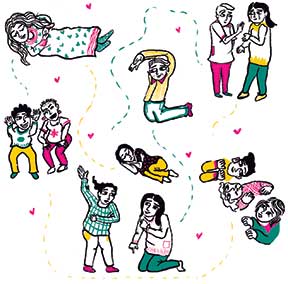
These games and activities can be applied to any discourse, theme, or syllabus.
My approach has been to find a way to endow concepts or context to a movement, action, or game and find connections within the larger themes of the workshop or learning session. Whether it is within the library, or for the library practitioner’s own learning, embodied engagement can add dimensions to the work that precedes spoken language.
During an engagement on locating caste within the library, we played a game where people had to walk blindfolded down a path and stop when they felt an invisible line that was “built’ or mimed by the rest of the group. The intent of the game is to stop walking when you feel some sort of resisting energy. This is usually a clowning game to sharpen physical and collective awareness and it’s uncanny how many people can actually sense an invisible line in the room (without having seen it in advance) and stop mid-way.
Participants shared how the exercise shook them up, how it solidified something from lived experience about how caste operates in silence and invisibility. They shared how it triggered deep reflection on the theme in an unfamiliar (embodied) way.
Process and performance-centric play
The presence of theatre and drama education in mainstream education is minimal to negligible. Contemporary theatre in India is largely underfunded and inaccessible, which means that as adult learners, unless someone is deeply interested in theatre, it is rare to have any access to the form – especially in the urban or peri-urban context. Folk and vernacular modes of theatre (while still vibrant) are bound by caste and ethnic identity and not practised outside of those boundaries.
Theatre-based work can be process-centric and/ or performance-centric.

Process-centric work uses these modes of play and the medium for its own sake, for the effect it has on the group’s trajectory through a workshop. It sees the experience of creative play as an end in itself and recognizes the psycho-social and emotive shifts such creative, embodied exploration can activate.
Performance-centric work sees a more linear trajectory, where the end result is a sharing or presentation of a devised theatrical performance.
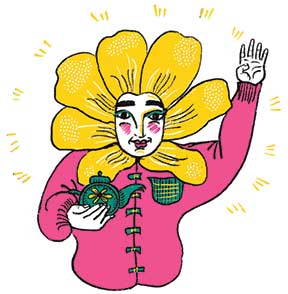
This can be as conventional or experimental as is fitting, but always allows the group to encounter the collaborative, multi-modal, and frankly delightful process of making a play.
There are many overlaps between the two. But while you can keep doing process-centric work without including performance as an element, it is impossible to create a performance without allowing the process of exploration to happen first.
I enjoy using both, with an emphasis on the process.
In the context of LEC and other library practice workshops, participants are usually educators, community or school library practitioners, or NGO workers.
The vast majority of people I’ve worked with have never done theatre, have rarely experienced the act of physically-located play past their childhood, and have never been required to play in the formal setting of a professional development course or educational context. It often takes a long time to immerse in the processes – to reflect on and break out of social scripts of shyness, competitiveness, or “seriousness”, and to give in to the instinct to play.
To allow for this immersion, sometimes the focus may remain at the level of playing for its own sake. Due to time constraints, we cannot always engage with performance-making, since this requires rigour, time, and attentiveness to detail – and its own set of domain-specific scaffolding.
The facilitator would need to lead the group through different elements of performance: from playing with characterization, to set design and scripting, voice and movement training, to thinking of production elements, bringing attention to sound design, direction and blocking, and allowing for lots of rehearsing and feedback.
For the facilitator to have experience in theatre would be helpful to support participants through this nitty-gritty. Although with sufficient enthusiasm and research, this isn’t compulsory.
For the participants, the payoff of seeing your peers create and inhabit a story from nothing and the experience of making something with them that becomes a transient parallel reality…is unmatchable.
It is a completely a new way of being and still a fundamentally human experience.
Within the library: Supporting the play instinct
Within the library, playfulness and performance can affect space, atmosphere, interactivity, and engagement with stories and storytelling and contribute to creating a vibrant library.
Children respond very strongly to play, and it’s important to recognize that children have physiological needs and rhythms that can find expression and fulfilment in physical play.
I’ve noticed in my sessions that it’s often the practitioners who work with children already, who respond to this work and see its relevance faster than those who have not worked in the field before. These sessions aim to foreground the power of modes of story-making that transcend language, as well as a means of human connection that transcends age or social context. They experience this connection with strangers and peers. As these adult learners start to inhabit the space of playfulness, they may find it easier to create this for children.
These sessions are also meant to sensitize the library educator to the potential they hold in their own body – to encourage experimentation – using their voice, becoming a character, changing how they conduct storytelling sessions or thematic engagements.
Adapting and using storybooks to build performances is an especially powerful practice. It can change a reader’s relationship to the text – it can support reading, decoding, and reflective engagement.
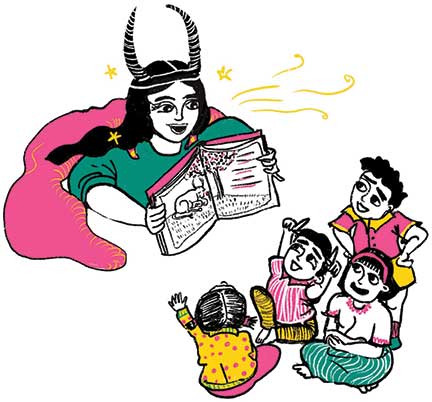
It can allow participants to inhabit unfamiliar or difficult contexts, and also respond to difficult themes such as death, conflict, or emotional dysregulation. It can encourage picking up the books and stories that have been explored through performance.
To have theatre and drama as part of a library program would provide a medium of expression that supports personal and collective development in a completely new way.
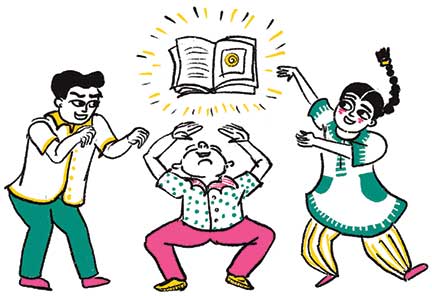
For children who have not had access to theatre and performance elsewhere, exploring it within the library could open doors and windows into different worlds, give language to that which can’t be spoken and give form to ways of seeing the world that don’t yet exist.
The hope is that this work will feed the facilitation practice of all those who participate and provide them with a menu of activities, games, and methods to take back to their own libraries and organizations.
Some things I keep in mind as a facilitator
Reflecting on my role as a facilitator in these sessions, I’m struck by how it feels distinct from a teacher, professor, or instructor.

As the learning only happens through the act of doing, much of the session is dependent on the active presence of the participants. So one is focused on creating the conditions that will allow them to participate freely and discover the work rather than on imparting a set of facts, figures, or concepts. There is no top-down flow of information. One is part of the group, located within and alongside the circle.
Establishing safety and physical boundaries is a fundamental area of attention – to know who in the group is comfortable with what extent of movement and touch. I must allow space for people to point out their boundaries – holding hands, or linking arms may be more acceptable than more intimate physical contact that theatre demands, like leaning on each other back to back.
Some participants may be older, uncomfortable with physical expression, disabled, dealing with illnesses or chronic conditions that restrict mobility or other constraints. As a medium that is so physically concentrated, theatre and play may easily become exclusionary, so it’s important to design the sessions to take into consideration different participants’ needs and abilities.
It is crucial to establish care for each other’s bodily vulnerability and autonomy as a culture of these sessions to look out for people, to avoid injury during vigorous movement, to include everybody, and to be respectful in conduct.
The significance of language while conducting the sessions is astonishing. I have to remember to give clear instructions, repeat them, and demonstrate whenever required with the help of volunteers.
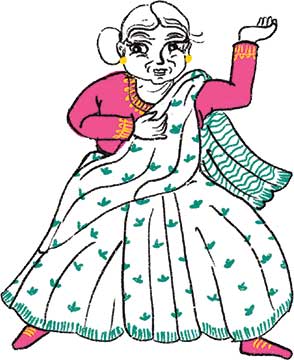
Apart from the prompts themselves (which have to be convincingly given no matter how strange they seem), the tone and approach while dealing with conflict or resistance can significantly impact the session.
I have to respond to whatever the group is feeling or thinking or doing – to become a permeable membrane that can intuit whatever the group needs in that moment and address it with lucidity and gentleness.
Feedback and debriefs during and after sessions are important to understand where people are at, and how they’re processing the work.
Music can be a powerful tool during these sessions – either to accompany, prompt, and enhance certain activities. Whenever a speaker is available, I make it a point to use music.
In more recent times, I have developed a broad sense of what activities work in what combination with which group. The struggle has been to refresh these plans, to remember to take risks and try new things after sufficient research.
The session is often most successful when I come to it from a place of excited uncertainty.
What it looks like
You may be wondering at this point what the responses to these sessions have been.
While in the beginning it can range from confusion and tentativeness, I’m always amazed at the openness with which groups surrender to the session – often while being unsure of why they’re doing it.
Playing provokes many beautiful reactions – my favourite is the sheer mirth and silliness. But it can also go from excitement to deep reflection, sometimes unlocking emotional reactions such as uncontrollable laughter or tears. It is a testament to the form, that somatic and embodied work can open floodgates of emotion and deep thought, through the simplest of things (like dancing in a room with your eyes closed).
I have often used playful frameworks to address difficult themes – there’s a whole set of games around COVID 19 for example, where you’re either somebody infected with COVID, or a giant COVID cell, or even a hospital for COVID patients. These usually allow for ridiculous, hilarious moments, all while dealing with a very charged and heavy topic.
The act of play feels fundamentally political – the way it can subvert traditional notions of education or of competitiveness, the way it allows for fears and anxieties to be confronted with humour, the way it centres collaborative joy and care. The potential it has to address social and political issues could be a whole other essay.
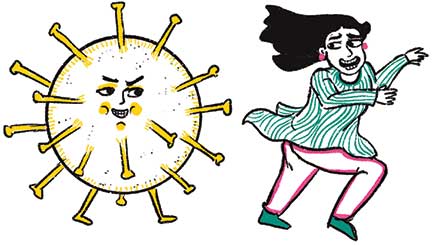
There is something about playing with other people that is disarming – that reveals sides of them you may never have imagined or had the honour to observe otherwise. It may be the way someone dances, or the way they scream while running away from a giant COVID cell. It may be a particular wittiness during some group work, or a deeply affecting dignity that comes through in a performance.
I cannot think of many spaces or situations in contemporary times that match the feeling of communion – a low soaring, shared euphoria – when a play and performance session has flowed beautifully.
Time and time again, my colleagues and I have observed groups before and after sessions of play and performance, and found the group warmer, kinder, more bonded with each other.
The vulnerability and openness that play enables for the participants – many of whom are practitioners and educators – seep into their other engagement with the rest of the course.
To be able to encounter these things within a learning context, feels super-charged with potential for further study. It would be exciting to track and maintain responses about the long-term effects of this kind of engagement.
I hope that playing can and will be taken more seriously within pedagogical and educational spaces in India and that more exploratory and experimental work in these fields will emerge, astonish, and delight learners in the generations to come.
The author is currently leading ‘Khwab Ghar’, the Library Program of Aagaaz Theatre Trust, in New Delhi. She is a theatre practitioner and freelance illustrator and you can see more of her work at www.instagram.com/minor_grace. She can be reached at moontuner@gmail.com.
